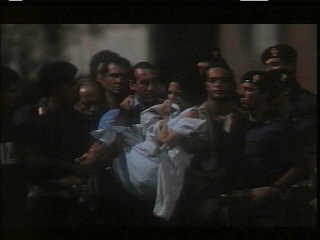
**Spolierlicious-
beware!**
It isn't really a surprise, I guess, to find out that Anna is the killer
after her dispatching of Alfredo. We see in her self-cuttings the
influence that he has exerted upon her, and the way that each chance she
has at happiness is brutally cut loose. In a way, The Stendhal Syndrome is
kind of like a 180-degree flip from David Cronenberg's Scanners. In that
film's conclusion, the mad scanner Revok 'wins' in a duel of psychic
energy, annihilating the physical body of his brother, but the brother's
consciousness now inhabits Revok's body, letting all the blood and
exploding veins and such serve as a fertilizing rather than a destructive
event. Anna 'wins' in that she kills Alfredo and dumps his body off a
cliff, but his killing impulse and desire to methodically destroy her life
lives on in her. What's really messed up, in fact, is the way that Anna's
Stendhal Syndrome is only vanquished when she assumes some of the
attributes of Alfredo. Briefly in Viterbo she becomes a creator, painting
her own work, but this doesn't make it stop. It is only once her psyche
fragments and she begins to act as Alfredo that she truly creates, and
sadly, instead of painting, it is murder.
This is certainly one of the cruelest films to emerge from late-nineties
horror, and I would call it one of the bleakest efforts I've ever seen if
not for one grace note, one shining beacon of hope at the very end. As the
policemen carry Anna away, it is not with intensity and pride at having
caught a killer, rather it is with delicacy and care- they know her both
as one who has endured the most horrifying of tragedies and as one of
their own, and there is something very moving and beautiful about that
final image of them carrying her.
